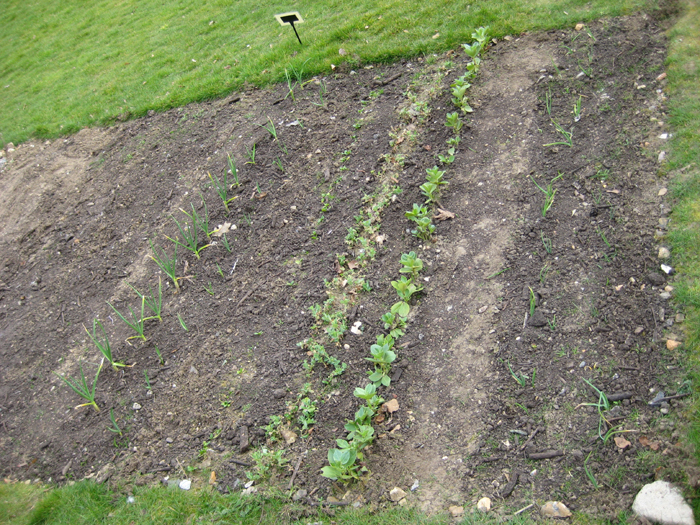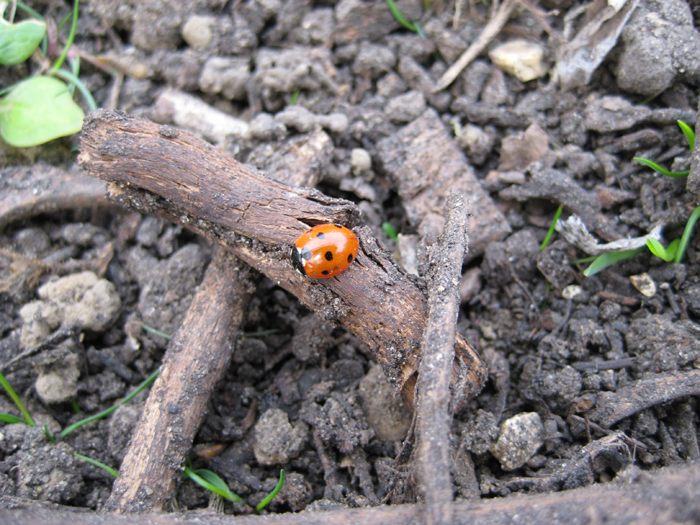The Allotment Plot thickens with another Planting Performance in the Garden at MERL (18/03/2010). The weather conditions were good for planting again. The day was pleasantly warm with the Spring equinox approaching. Rain was in the forecast and needed, but that did not occur until the evening when darkness fell.
Ella Montt selected seed packets, some tools, gardening gloves, a small bell, a thermos and a measuring stick and placed the objects next to Allotment Plot. Then with a hoe and small hand fork proceeded to remove some grass plants growing on the Plot. Shallow drills were constructed with the hoe, these were ground incisions for seed accumulation in the planting process. The first seeds were delivered to their destinations. The bell was rung along the line of seeds to awaken them from dormancy to germination state. The hoe was then utilized to cover the seeds with the soil to complete the planting process. More seeds were chosen and the process of planting began again.

As the Allotment Plot thickens, Ella Montt pauses to observe the notes written about the seeds that had previously been planted. Ella Montt drinks a cup of tea from the thermos, a normal activity for a person or persons working on their allotments and part of the Performance. Pondering on the size of the Plot, and the space limitation, Ella Montt decides that an optimum number of seeds should be planted. This would maximize the Plot and may retain more water through ground coverage rather than water evaporation process taking place in a drought situation. Irrigation would be ideal and a water butt close to hand, but this is not a current option. Ella Montt is conscious that intensive farming can destroy the fertility of the soil.
The notion of what to grow and how to grow it, can be calculated and assisted. Ella Montt chooses to grow organically without the assistance of animal by products, but with the assistance of biodiversity present within the Garden, a veganic method. A ladybird (ladybug) arrives on the scene at the Allotment Plot, a very welcome guest, who will assist in pest control. One perhaps could wonder if a vegan (who eats plant based foods), should choose the biodiversity of wildlife as a form of natural pest control in the growing method of plant based food products. A genetically modified seed could grow without the use of natural wildlife pest control, no insects or animals would be harmed in the growth of the food product. However, genetically modified food production results in the loss of biodiversity, it breaks the food chain for insects and animals, resulting in the loss of species on the whole planet. Using the immediate gratification of growing genetically modified crops as an answer to world need for food production becomes its own fictional myth and as a consequence produces its own catastrophe not just through the loss of species, but also through crop failure and the ingestion of genetics that are in themselves harmful to the being that eat them. Veganic growing uses no animal by products to fertilise the soil, it instead relies on green manures and composting to make the soil fertile and it encourages biodiversity of insects and animals to act as agents in pest control, and the use of companion planting which is also very important in the growing process.

Seeds that were planted during the Planting Performance were as follows:
Leek Almera, Kale Red Russian Curled, Spinach Matador (Atlanta), Leaf Beat Rainbow Chard, Beetroot Bolivar, Cabbage Savoy (Vertus), Rocket Wild, Lettuce Lollo Rosso, Spring Onion White Lisbon, and Lettuce Marvel of Four Seasons. What will germinate and grow for now remains a mystery, but hope for a good harvest will be constant.
The coldest winter in thirty years awaits the coming of warmer weather. Later that day, a bee was seen, a frog hopped by in search of a pond and a snail arrived to eat the vegetable crop. The growing cycle continues.